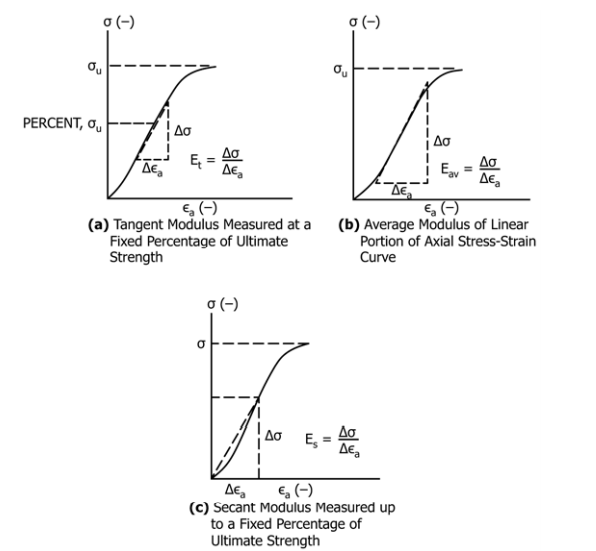Hi, it would be great if someone can help me.
I'm making a study following the ASTM Standard test method D7012. This paper describes the analysis of Uniaxial Compressive Strength of core rocks, well, in order to calculate Young's modulus, this paper describes 3 options to calculate, the tangent modulus, the secant modulus, and the average modulus. The problem is that I'm not understanding the way you calculate this modules, and what's the difference between them.
This are the only descriptions of the modules.


and, from the test, I obtain something like this (it's not complete)

So...
-In the tangent modulus, it says that I should calculate it at a fixed percentage of ultimate strength. As I understand, by that explanation, and the graphic, I should select the central 50% of the data, and I take the tangent modulus as the slope of the curve.
-In the Secant modulus, I don't understand what will be the fixed percentage of ultimate strength, and how to calculate it.
-In the average modulus I understand that I should plot the linear section of the curve, and calculate the slope of the curve.
I would really appreciate any help you can give me.
P.S. Sorry for bad english.
Best regards.
I'm making a study following the ASTM Standard test method D7012. This paper describes the analysis of Uniaxial Compressive Strength of core rocks, well, in order to calculate Young's modulus, this paper describes 3 options to calculate, the tangent modulus, the secant modulus, and the average modulus. The problem is that I'm not understanding the way you calculate this modules, and what's the difference between them.
This are the only descriptions of the modules.


and, from the test, I obtain something like this (it's not complete)

So...
-In the tangent modulus, it says that I should calculate it at a fixed percentage of ultimate strength. As I understand, by that explanation, and the graphic, I should select the central 50% of the data, and I take the tangent modulus as the slope of the curve.
-In the Secant modulus, I don't understand what will be the fixed percentage of ultimate strength, and how to calculate it.
-In the average modulus I understand that I should plot the linear section of the curve, and calculate the slope of the curve.
I would really appreciate any help you can give me.
P.S. Sorry for bad english.
Best regards.

![[smile] [smile] [smile]](/data/assets/smilies/smile.gif)